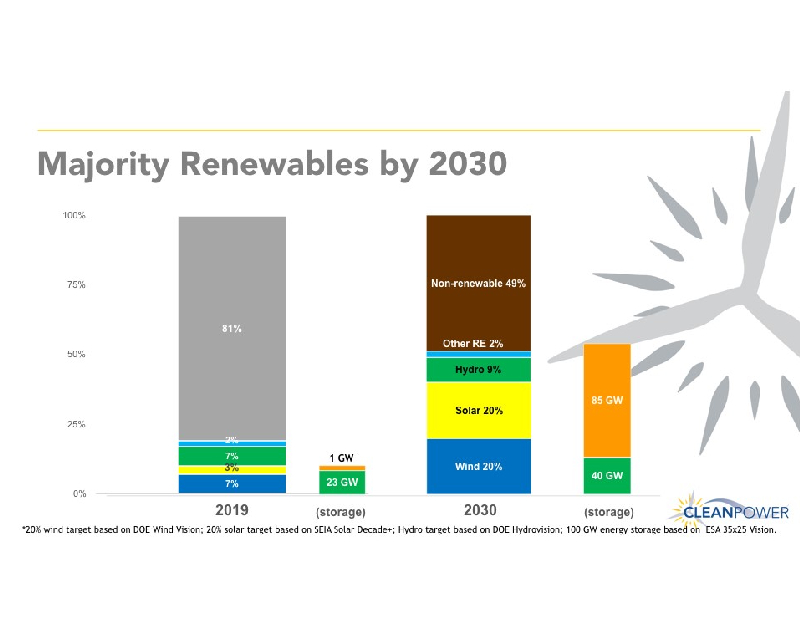Renewables Industry Eyes Majority Rule
National wind, solar, hydropower and storage associations embark on a transformation of power generation over the next decade.

The roadmap for achieving 20 percent wind by 2030 will include dealing with the problems of siting such as scale and visibility. Image courtesy of AWEA
Over the past few years, forward-looking cities in the U.S. have committed to lofty renewable energy goals that may have seemed overly ambitious. But a new alliance of four renewable industries—solar, wind, hydropower and storage—is committing to reaching a majority renewable grid by 2030.
The collaboration will enable the American Wind Energy Association (AWEA), Solar Energy Industries Association (SEIA), National Hydropower Association (NHA) and Energy Storage Association (ESA) to reach the following targets by the end of the decade:
- wind power from 7 percent to 20 percent;
- solar from 3 percent to 20 percent;
- hydro from 7 percent to 9 percent.
READ ALSO: Are Microgrids the Answer to Energy Disruptions?
The announcement was made during the CleanPower Conference, held in June as a virtual event, where the leaders of the associations spoke at length about their shared vision. Together they intend to build a more resilient, efficient, sustainable and affordable grid. Achieving carbon reductions and advancing greater competition through fair market rules are critical to attaining their goals by 2030.
“The path towards an affordable, reliable, carbon-free electricity grid starts by harnessing the immense potential of hydropower, wind, solar and storage to work together,” said Malcolm Woolf, president & CEO of NHA.
Hydropower and pumped storage have become force multipliers, providing the flexibility to integrate other renewables onto the grid, Woolf said. “By adding new generation onto existing non-powered dams and developing 15 (gigawatts) of new pumped storage hydropower capacity, we can help accelerate the development of a clean energy electricity grid.”
According to Abby Hopper, president & CEO of SEIA, last spring the solar association had visioning sessions from which the concept of the Solar Plus Decade emerged. “We are here together and we are each other’s plus one,” Hopper said. “It’s a competitive marketplace, and by sticking together renewables will better be able to take the market share.”
From Alternative to Mainstream
Although renewables are still widely referred to as alternative, they are now part of the nation’s mainstream power system and are rapidly transforming it. They account for almost a quarter of the nation’s generating capacity (23.1 percent in 2019) and are the fastest-growing source of total electricity generation in the country, according to Marlene Motyka, Deloitte’s global and U.S. renewable energy leader.
Solar, wind and storage all saw record growth in various areas in the first quarter of this year, Motyka noted. In fact, the U.S. Energy Information Agency expects wind and solar to account for over three quarters of planned U.S. electric generating capacity additions in 2020.
“Renewables have also surpassed coal. And beyond electricity, renewable energy consumption grew to a record high in 2019, surpassing coal for the first time in 135 years,” Motyka said. Looking forward, renewable deployments themselves are transforming: Solar deployments will increasingly be paired with storage and wind deployments will increasingly occur offshore.
READ ALSO: Solar Installations Power Through the Pandemic
“While the joint initiative’s vision of more than half of the electricity generated in the U.S. by 2030 is ambitious, it doesn’t appear overly ambitious, especially if all of these organizations are working together toward that goal,” Motyka said. Indeed, just last week, the University of California Berkeley released a report showing that it would be technically and economically feasible to achieve 90 percent carbon-free electricity in the U.S. by 2030.
The energy transition to renewables has accelerated amid the pandemic, Motyk observes. While electricity demand has decreased overall, the renewable share of electricity generation has increased, reaching record-high hourly shares thanks to low operating costs and preferential access.
“The suddenly higher renewable shares have demonstrated that utilities can continue to reliably operate the grid when renewables dominate generation,” Motyka added.
Obstacles to Avoid
With the costs of renewables and storage falling quickly, it’s possible to rapidly accelerate the deployment of clean energy over the next decade and achieve more than 50 percent of electricity from renewables, according to Lori Bird, U.S. energy director at World Resources Institute.
“Scaling up renewable energy will be necessary to achieve net-zero CO2 emissions by mid-century in order to avoid catastrophic impacts of climate change,” Bird said. Furthermore, achieving the majority of electricity from clean energy sources is consistent with the findings of other studies, including studies by the Department of Energy and a new study examining a pathway of 90 percent clean energy, including nuclear by 2035.
Bird pointed out that some of the key challenges to the expansion of renewables and storage include: Building sufficient new transmission to access the windiest sites, successfully deploying offshore wind, reforming utility business models, implementing electricity market reforms and removing siting and interconnection barriers.
READ ALSO: JPMorgan Chase to Restrict Fossil Fuel Project Funding
“Currently, according to the U.S. Energy Information Administration, about 18 percent of U.S. electricity is provided by renewable energy sources,” Bird said. Renewable energy can be used to displace fossil fuel consumption in buildings and transportation through increasingly electrifying loads.
“In residential and commercial buildings, renewables can displace natural gas consumption for space heating, hot water and other uses through increased electrification, such as use of electric heat pumps and water heaters,” Bird noted, adding that renewable energy can also displace oil used for transportation as we expand the use of electric vehicles.
The unified voice of the solar, wind, hydropower and storage associations will be crucial in future conversations on Capitol Hill, because it sends a signal that economic change is coming. The joint initiative is expected to create thousands of new jobs.







You must be logged in to post a comment.